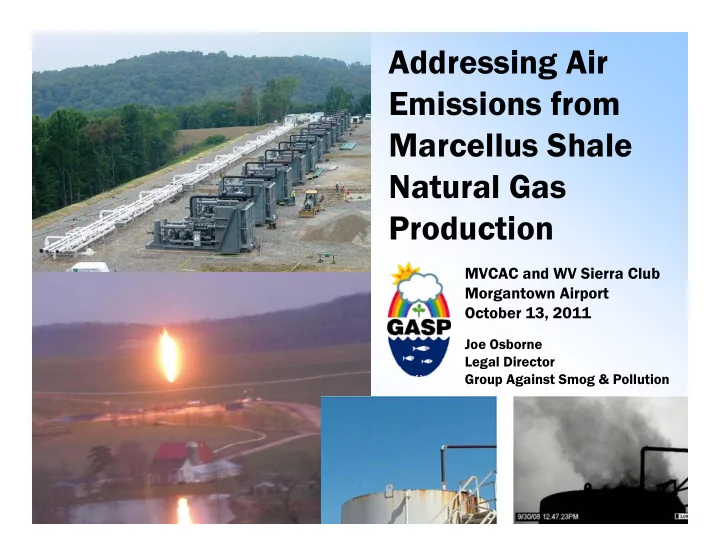

Addressing Air Emissions from Marcellus Shale Natural Gas Production MVCAC and WV Sierra Club Morgantown Airport October 13, 2011 Joe Osborne Legal Director Group Against Smog & Pollution
What Pollutants are Emitted? 1. Ozone and PM precursors: •Volatile Organic Compounds •broad class of high vapor pressure organics •some carcinogenic •eye & respiratory tract irritation, headaches, dizziness •Nitrogen Oxides •acid rain •respiratory inflammation, exacerbates asthma
What Pollutants are Emitted? 2. Methane • primary constituent of natural gas (~80% by weight) • potent greenhouse gas (~21 times more powerful than CO 2 ) • explosive • oil and gas sector responsible for 18% of methane emissions worldwide
What Pollutants are Emitted? 3. Hazardous Air Pollutants • benzene, toluene, ethylbenzene, xylenes • benzene is a known human carcinogen • neurotoxic/reproductive/developmental effects • formaldehyde • possible carcinogen, asthma, coughing, fatigue, allergic reactions • may be elevated hazardous air pollutant concentrations near natural gas operations
What are the emissions sources? 1.Compressor Engines • fugitives • exhaust 1200 hp compressor: NOx –6 TPY CO – 1.5 TPY VOCs – 1.5 TPY HAPs – 0.5 TPY (formaldehyde)
Emissions Sources in Marcellus Shale Operations 2. Condensate Tanks • source of VOCs
What are the emissions sources? 3. Production/Transmission Fugitive Emissions • leaking pipes, valves, flanges 4. Gas Processing • dehydrators • heaters
What are the emissions sources? 5. Well Completions
The Oil and Gas Sectors’ Contribution to Ambient NOx and VOC can be Enormous Consider other areas where drilling is common: • A 2009 Southern Methodist University Study concluded that in the 5- county Dallas-Fort Worth area annual NOx and VOC emissions from the oil and gas sector exceed emissions from all motor vehicles. • A 2008 analysis by the Colorado Department of Public Health and Environment concluded that VOC and NOx emissions from Colorado’s oil and gas operations exceed motor vehicle emissions for the entire state. • In 2009 several years of elevated ozone readings (including elevated wintertime readings) lead Wyoming to request its first ever nonattainment designation. Wyoming DEQ states nonattainment “is primarily due to local emissions from oil and gas (O&G) development activities.”
What about DEP’s Air Toxics Study? What the press said:
Limitations of the Air Toxics Study • DEP study was focused on Air Toxics, not NOx or VOCs • DEP monitored for 44 pollutants at 12 Marcellus Sites • focused solely on concentrations high enough that short-term exposure would pose a health risk. • DEP’s monitoring equipment was not sufficiently sensitive to detect several pollutants unless they were well above short term exposure levels
Limitations of the Air Toxics Study • Measured pollutant concentrations are only reliable to the extent the 12 natural gas sites are representative of routine operation at all PA natural gas sites . . .
Limitations of the Air Toxics Study • No consideration of long-term exposure risk. • No consideration of cumulative impact on regional ozone or particulate matter levels.
What DEP actually said: “Due to the limited scope and duration of the sampling and the limited number of sources and facilities sampled, the findings only represent conditions at the time of the sampling and do not represent a comprehensive study of emissions.” “this short-term sampling effort does not address the cumulative impact of air emissions from natural gas operations”
The Marcellus Shale Play, and Other Shale Formations in the Region are Perfectly Situated to Worsen Existing Ozone and PM Nonattainment in the Midatlantic and Northeast
Limitations of Existing Laws Many Sources are exempt from Installation & Operating Permit Requirements • 45 CSR 13 “de minimis” sources • No need to provide notice of intent to install emission unit to DEP • No notice = • No means for permitting authority to verify source meets, exemption requirements, emission rates, employing required control measures • emissions not included in emissions inventory • 2010 University of Texas air monitoring suggests TCEQ Ozone Attainment modeling underpredicted NOx by 20%
Limitations of Existing Laws: Compressor stations permitted as “minor sources”
Solutions: 1. Notification requirement for all stationary emission units associated with natural gas operations • include process description, emission units list, potential to emit • not as onerous for source operator as a full permit application, most information can be obtained from vendor spec sheets, AP- 42, etc. • provides Air Program with knowledge of emission units on site without having to perform an inspection • allows Air Program to determine if exemption criteria are satisfied: • is source major? • are emission limits/rates, pollution control requirements met? • provides better estimate of emissions for emissions inventory • 2010 University of Texas air monitoring suggests TCEQ Ozone Attainment modeling underpredicted NOx by 20%
Solutions: 2. Adopt narrowed air de minimis source criteria • well site general permit • adding well sites to existing compressor station general permit 3. Control devices for this industry are cost effective. • many pay for themselves in a year or less Control Measure Up Front Cost Payback Period green completions $1000-10,000 1 year vapor recovery units >$10,000 <1 year install low bleed or <$1000 <1 year mechanical valves leak detection program <$500 Varies, Gas STAR participant reported payback in <1 year EPA Gas STAR program, http://www.epa.gov/gasstar/tools/recommended.html Armendariz Report (2009), http://www.edf.org/documents/9235_Barnett_Shale_Report.pdf
Solutions: 4. Enforce aggregation requirements
Questions? Questions? joe@gasp-pgh.org joe@gasp-pgh.org
Recommend
More recommend